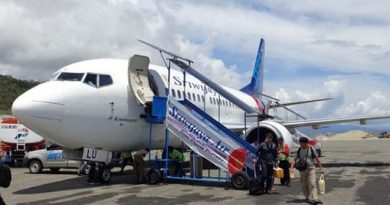How Are Indonesia’s Four Priority Tourism Destinations Coming Along So Far?

Indonesia is eager to boost its revenue by attracting more overseas visitors, while also encouraging foreign investment in the country’s tourism sector.
To achieve this, the government is promoting tourism destinations other than Bali, which is widely considered one of the world’s best holiday spots.
Tripadvisor, the world’s largest travel site, announced its Best Travelers’ Choices this month, which featured Bali in fourth place in the top destinations category, making the island Asia’s best tourism destination.
Indonesia announced plans in 2016 to prioritize the development of 10 tourism destinations across the archipelago – known as the “Ten New Balis” due to their potential to boost the country’s tourism industry. The list includes Wakatobi in Southeast Sulawesi, Morotai in North Maluku and the Thousand Islands in Jakarta.
With ongoing plans to develop infrastructure and amenities in selected locations, attract more investment and advance tourism, Indonesia appears on track to achieving its ambitious target of attracting 20 million visitors annually by 2019.
Government officials have been vigorously promoting these locations ever since, while President Joko “Jokowi” Widodo has been raising the matter in his meetings with foreign leaders and business groups abroad as part of efforts to attract both tourists and investments.
The Ministry of Tourism also actively engaged in various promotional efforts, with Wonderful Indonesia billboards in Times Square in New York and Shibuya Crossing in Tokyo.
Despite continuous eruptions of Mount Agung in Bali since last year, Indonesia welcomed 14 million foreign tourists in 2017 – an increase of almost 22 percent from the year before, though still short of the 15-million target.
The shift from Bali as the country’s main tourist destination is expected to aid plans to attract more foreign tourists, which is expected to boost foreign-exchange earnings and increase employment.
The World Travel and Tourism Council estimates that Indonesia’s current efforts to develop its tourism industry will help generate 2.4 million new jobs in the country.
The Tourism Ministry said in November last year that development will be refocused on four of the original 10 locations. These are Lake Toba in North Sumatra, Borobudur in Central Java, Mandalika in West Nusa Tenggara and Labuan Bajo in East Nusa Tenggara.
Coordinating Maritime Affairs Minister Luhut Pandjaitan said efforts to develop these locations would be integrated to make the results more effective and eliminate mistakes as far as possible.
Various efforts have also been directed at promoting these areas a “digital destinations” to further popularize them on social media.
While the natural beauty of these priority destinations is undisputed, what has the government been doing to facilitate a better experience for visitors to these locations?
Lake Toba
As part of efforts to turn Lake Toba into an international-standard destination, the government has improved access to the area by upgrading the nearest airport. Silangit International Airport in North Tapanuli, North Sumatra, started to serve direct flights from Singapore and Malaysia in October last year. It previously took travelers around five hours to reach Lake Toba from Kualanamu International Airport outside Medan.
Lake Toba, which has launched a bid to become a Unesco-designated Global Geopark, will take adopt the concept of nomadic tourism, especially as a means to improve amenities.
“We are realizing this nomadic tourism concept with a pilot project at Lake Toba, and a groundbreaking event is scheduled for April. Once it starts, we will also develop it in other priority destinations,” Tourism Minister Arief Yahya said, as quoted by BeritaSatu.com.
The nomadic tourism concept will likely focus on accommodation, with plans to provide a “caravan hotel” that will allow tourists to visit different areas without having to worry about accommodation. Arief said this should be a solution to provide quality accommodation for the time being, while accredited hotels are being built for years to come.
Local communities are also encouraged to provide quality homestay experiences for visitors, as part of an integrated approach that seeks to preserve the natural beauty of Lake Toba while developing the area into a thriving tourism destination.
The government said in November that 40 foreign investors, including from Singapore and China, had expressed an interest in developing the Lake Toba area.
The government also established the Lake Toba Authority Agency to easy the investment process.
Labuan Bajo
Komodo National Park, a Unesco World Heritage Site where visitors can see komodo dragons in their natural habitat, is located on one of Labuan Bajo’s three main islands.
Komodo Island was declared one of the new seven wonders of nature in 2011.
The hills of Labuan Bajo and the surrounding waters have started to feature on Instagram, further enchanting travelers to visit this destination, which was relatively unknown until just a few years ago.
The waters of Labuan Bajo offer some of the best diving spots in Indonesia, while visitors can also view a rare phenomenon – Pink Beach on Komodo Island.
The increasing popularity of Labuan Bajo has in recent times seen an influx of investment into the area.
The upcoming 2018 Annual Meetings of the International Monetary Fund and World Bank, scheduled to take place in Nusa Dua, Bali, in October, is expected to attract around 15,000 participants from 189 countries. The proximity and increasing popularity of Labuan Bajo and neighboring Mandalika as tourist destinations are likely to see many of the participants extend their visits.
In Labuan Bajo, the government is working to improve access to water and electricity, building roads and another port, as well as speeding up development of an international airport. Officials hope to finalize these before the start of the event.
Mandalika
In Mandalika, situated on Lombok Island in West Nusa Tenggara, tourists can visit two traditional villages of the Sasak tribe to experience ancient traditions. Besides the villages – Sade and Ende – the area also provides beautiful views of the hills and sea.
And in addition to Mount Rinjani and the Gili Islands, Lombok also has the 1,034-hectare Mandalika Special Economic Zone.
The special economic zone, which was inaugurated in October last year, is focused on agriculture and ecotourism and will be used to promote the culture and economy in the province. The area will serve to help popularize local architecture, traditional crafts and cuisine.
Similar to neighboring Labuan Bajo, waste has been one of the main issues, which prompted the government and the local community to combine efforts to address this and preserve the area. These efforts included cleanup actions and campaigns to educate local residents.
BeritaSatu.com reported that during their visit to Qatar in December last year, Minister Luhut and West Nusa Tenggara Governor Muhammad Zainul Madji invited investors from the Gulf state to invest in Mandalika.
These investments are needed to expand Lombok International Airport, build roads and develop supporting facilities, such as hotels.
Borobudur
Development of this destination in Central Java has largely been coordinated by the Borobudur Tourism Authority Board (BOB), which oversees tourism in the area.
The BOB has reportedly been coordinating with stakeholders in surrounding destinations such as Sangiran, an archaeological site, and Karimun Jawa, a small archipelago near Semarang, in an effort to diversify tourism attractions in the province.
Infrastructure developments include new highways between Bawen and Yogyakarta and Semarang and Solo, renovations of Achmad Yani International Airport in Semarang and construction of Yogyakarta’s new Kulonprogo Airport.
The regional government is also revitalizing the iconic Jalan Malioboro in Yogyakarta.
According to a report by Investor Daily, there are currently 17 tourist villages in Yogyakarta. The village tourism concept, which allows foreign visitors to stay with residents and learn about their culture, history, art and daily lives, has also become popular in the area in recent years.
Courtesy : JakartaGlobe
Photo : Dream
[social_warfare buttons=”Facebook,Pinterest,LinkedIn,Twitter,Total”]



